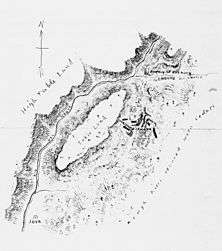Battle of Embudo Pass
| Battle of Embudo Pass | |||||||
|---|---|---|---|---|---|---|---|
| Part of the Taos Revolt, Mexican-American War | |||||||
 Sketch of battle site by United States Army Corps of Engineers cartographer JG Bruff. | |||||||
| |||||||
| Belligerents | |||||||
|
|
| ||||||
| Commanders and leaders | |||||||
|
| unknown | ||||||
| Strength | |||||||
| 180[1] | 600-700[1] | ||||||
| Casualties and losses | |||||||
|
1 killed 1 wounded[1] |
20 killed 60 wounded[1][2] | ||||||
The Battle of Embudo Pass was part of the Taos Revolt, a popular insurrection against the American army's occupation of northern New Mexico. It took place on January 29, 1847, during the Mexican-American War, in what now is New Mexico.
Background
Following the Battle of Cañada, Sterling Price on 27 Jan. advanced up the Rio del Norte (Rio Grande), to Luceros where he was joined by Capt. Burgwin's Company, 1st Dragoons, Lt. Boone's Company A, 2d Regiment Missouri Mounted Volunteers, and Lt. Wilson's 1st Dragoons, bringing Price's force to 479 men.[1] On 29 Jan., Price marched to La Joya, where sixty to eighty insurgents were posted on either side of the canyon.[1] Finding the road by Embudo impractical for artillery or wagons, Price detached three companies under Captain John H.K. Burgwin, Captain Ceran St. Vrain and Lieutenant B.F. White, amounting to 180 men.[1]
Battle
Capt. Burgwin discovered the insurgents at El Embudo, near present-day Dixon, New Mexico, in the thick brush on each side of the road where the gorge becomes constricted.[3]:140[1]


Sterling Price's official report of the battle describes it as follows: "The rapid slopes of the mountains rendered the enemy’s position very strong, and its strength was increased by the dense masses of cedar and large fragments of rock which everywhere offered shelter. The action was commenced by Capt. St. Vrain, who, dismounting his men, ascended the mountain on the left doing much execution. Flanking parties were thrown out on either side, commanded respectively by Lieut. White, 2d regiment Missouri mounted volunteers, and by Lieutenants Mellvaine and Taylor, 1st dragoons. These parties ascended the hill rapidly, and the enemy soon began to retire in the direction of Embudo, bounding along the steep and rugged sides of the mountains with a speed that defied pursuit. The firing at the pass of Embudo had been heard at La Joya, [now called "Velarde"] and Captain Slack, with twenty-five mounted men had been immediately dispatched thither. He now arrived, and rendered excellent service by relieving Lieutenant White whose men were much fatigued. Lieutenants Mellvaine and Taylor were also recalled; and Lieutenant Ingalls was directed to lead a flanking party on the right slope, while Captain Slack performed the same duty on the left. The enemy having by this time retreated beyond our reach, Captain Burgwin marched through the defile and debouched into the open valley in which Embudo is situated, recalled the flanking parties, and entered that town without opposition, several persons meeting him with a white flag."
Aftermath
Price's forces then marched on to Taos where they engaged in the Siege of Pueblo de Taos.
Local tradition states that a series of crosses were chipped into several large rocks marking the spots where defenders were killed. These can still be seen today.
See also
References
- 1 2 3 4 5 6 7 8 Sterling Price’s Official Report on the Revolution in New Mexico,in The Conquest of California and New Mexico, Cutts, J.M., 1847, Philadelphia:Carey & Hart, pp. 223-231
- ↑ Lavash, Donald R., ‘’A Journey Through New Mexico History’’, Sunstone Press, Santa Fe, New Mexico, 1993 p. 134
- ↑ Hughes, J.T., 1847, Doniphan's Expedition, Cincinnati: U.P. James
Additional Reading
- Twitchell, Ralph Emerson, The History of the Military Occupation of the Territory of New Mexico from 1846 to 1851, Denver, Colorado: The Smith-Brooks Company Publishers, 1909
- Herrera, Carlos R., New Mexico Resistance to U.S. Occupation, published in The Contested Homeland, A Chicano History of New Mexico, Albuquerque: University of New Mexico Press, 2000
- Cooke, Philip St. George (1964). The Conquest of New Mexico and California, an Historical and Personal Narrative. Albuquerque, NM: Horn and Wallace. pp. 114-115.